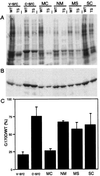Maturation of the tyrosine kinase c-src as a kinase and as a substrate depends on the molecular chaperone Hsp90
- PMID: 9874780
- PMCID: PMC15101
- DOI: 10.1073/pnas.96.1.109
Maturation of the tyrosine kinase c-src as a kinase and as a substrate depends on the molecular chaperone Hsp90
Abstract
Although Hsp90 displays general chaperone activity in vitro, few substrates of the chaperone have been identified in vivo, and the characteristics that render these substrates dependent on Hsp90 remain elusive. To investigate this issue, we exploited a paradoxical observation: several unrelated oncogenic viral tyrosine kinases, including v-src, attain their native conformation after association with Hsp90, yet their nearly identical cellular homologs interact only weakly with the chaperone. It has been controversial whether Hsp90 is vital for normal maturation of the cellular kinases or is simply binding a misfolded subfraction of the proteins. By modulating Hsp90 levels in Saccharomyces cerevisiae, we determined that Hsp90 is indeed necessary for the maturation of c-src (the normal homolog of v-src). c-src maturation is, however, less sensitive to Hsp90 perturbations than is v-src maturation. Dependence of the two proteins on Hsp90 does not correspond to their relative efficiency in reaching their final destination (the plasma membrane); we observed that in yeast, unlike in vertebrate cells, neither c-src nor v-src concentrate in the membrane. Expression of different v/c-src chimeras in cells carrying wild-type or temperature-sensitive Hsp90 alleles revealed that the difference between the proteins instead arises from multiple, naturally occurring mutations in the C-terminal region of v-src.
Figures





References
Publication types
MeSH terms
Substances
Grants and funding
LinkOut - more resources
Full Text Sources
Other Literature Sources
Molecular Biology Databases
Research Materials
Miscellaneous

